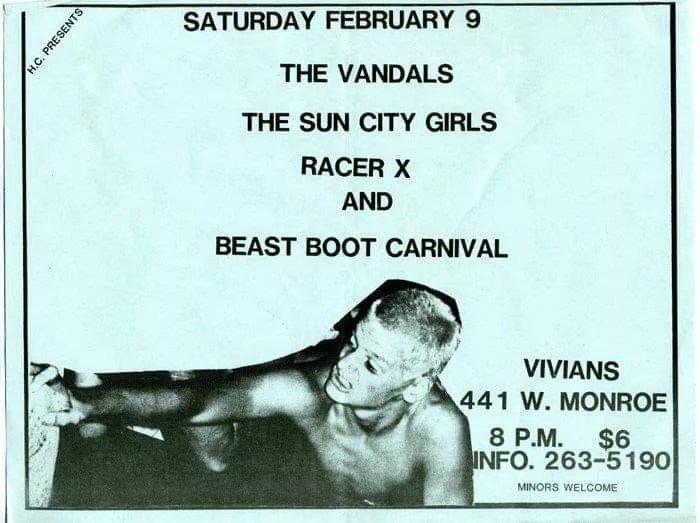
Courtesy of Robin Grotjan

Audio By Carbonatix
Punk rock is an attitude boiling in the hearts of discontented youth, but it also resides somewhere real: the city’s music venues. They could be sketchy houses, dive bars, or other assorted holes-in-the-wall. Phoenix has had a few such venerated halls over the years. While some lasted for decades (i.e., Mason Jar), others went belly up in record time. But these places mattered. In honor of their legacy, we’re commemorating four such shuttered havens. Our fair city’s all the better for their existence.
Be sure to check out the first part of our cover story here.
(Editor’s note: Some quotes have been condensed and edited for brevity and clarity.)
Will Tynor, Fan/Former Mason Jar Bartender
Silver Dollar Club
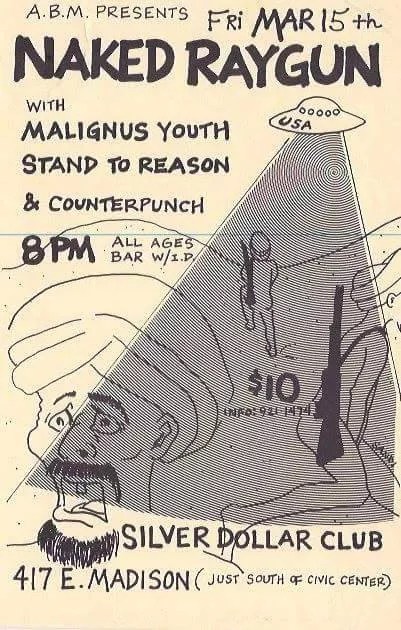
A Naked Raygun flyer circa 1992.
Courtesy of Remembering The Silver Dollar Club
A Different Land: “Silver Dollar is basically where the Suns’ arena [Talking Stick Resort Arena] is at now, and it ran from maybe the end of 1990 to the end of 1993. They were also known to do outdoor shows.”
Big History: “It’s one of my earliest shows [in Phoenix]. Jim Andreas of No Volcano was looking for people to jam and asked me if I wanted to meet there. The second time I went there, it was for Fugazi, which drew maybe 1,500 people, which was unheard of back then. I’m an Illinois boy, and I could tell friends in Chicago I saw T.S.O.L. and The Vandals.”
Bigger History: “I saw a lot of shows in that time, like Jawbox in ’92, and Naked Raygun, which [were] my favorite Chicago punk bands. I even saw an unknown band at the time, Face to Face, which turned everyone into a crowd of wild and screaming maniacs. I saw the very last show there with Green Day [in 1993]. That show sold out. There were as many people out front on the street as there were in the club.”
A Change of Pace: “Before Silver Dollar, there were places popping up, like a couple of warehouse shows and VFW shows. Silver Dollar was the first to have all-ages shows. At Mason Jar, they’d have T.S.O.L. play and then kick all the kids out, and then a formal show at 11.”
A Matter of Legacy: “[The premature closure] did harm the legacy. There’s something special about legacy. The fact is, national bands knew to play Phoenix [and] to play the Mason Jar. But before Charlie [Levy] opened up a place like Valley Bar, we didn’t have a midsize venue for a long time. A grungy-type place like Silver Dollar.”
Just the Start: “Downtown Phoenix is a lot cooler than what it was. It was all about sports and not The Van Buren or Crescent [Ballroom]. And that was really the [start] of all we’ve talked about: Silver Dollar was there and served its purpose.”
The Sonic Bridge: “I moved here in ’88, and I was trying to go to [Mesa Community College] and start a band. And looking back, there’s one thing I can say: There were places like the Sun Club or Madison Square Garden, [and Silver Dollar] was a link from the old punk guys to the new-school guys. They’d rep all the new kids on the block and melodic hardcore and even straight-edge bands. It really bridged the gap between ’80s hardcore and ’90s punk.”
Mike Modern, Musician and Promoter
The Star System
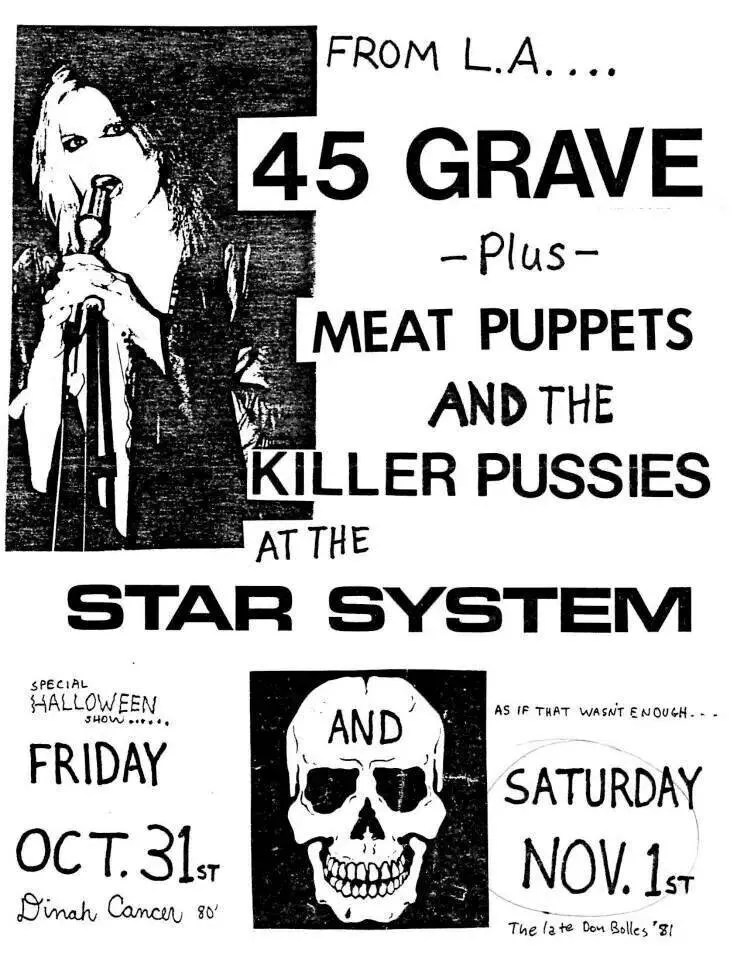
A flier from for Halloween weekend shows at the Star System.
Courtesy of Robin Grotjan
An Enterprising Start: “I was in a band called The Doctors. Our frontman had open-heart surgery, so we did a two-week benefit for him. The [owner] said if you like it, move back to [Arizona] and book three bands per night for two weeks. I’m from California, so I had the connections. We booked a lot of big bands, like Fear and The Go-Go’s, but I always included locals, like Jr. CHemists, Cicadas, and The Veins.”
Just Good Business: “Everyone was paid by the door. If they’d make $100, they’d get paid $100, regardless of whether one band brought in three people and another band brought in 100. You had to do what you had to do to show support.”
Smashing the Competition: “Other places, like Trout-O-Rama, just weren’t pulling it off. I had carte blanche, so I’d book bands for Phoenix, Tucson, and Hollywood. We’d run them through that circle, from Hollywood to Tucson to Phoenix and back. We could get better bands for cheaper that way.”
Forging the Future: “I was trying to make a club system out of it. Brad [Singer of] Zia was a big support, and he’d sell all the records coming from Hollywood and also boost the locals. Johnny D. [Dixon] interviewed every band for K-15.”
Going Legit: “It wasn’t about the money but exposure. I was exposed to the system in L.A., and you always played clubs. You couldn’t rent a ballroom and book one show and build a scene. But if you make money, you can do whatever you want.”
Putting on the Ritz: “The most we ever charged for the cover was $4. Phoenix was behind [other cities], but there were a lot of people grouping up to get the scene going. Everyone jumped on board to help.”
Arrested Development: “It only lasted two and a half years. I’m gonna tell you what happened: The owner was involved in some kind of theft. It just all happened so suddenly. Once I saw the mugshot, I knew it was all over.”
A Place in the Books: “We put on some big shows. I felt like it was part of the process [of building a scene], and it was a perfect storm that came together at the right time. We were a place people could go to and connect. Other places weren’t big enough or couldn’t pay enough. If I was still doing what I was doing, it would’ve worked. We would’ve become liquid.”
Closing Thoughts: “I’m 64 years old, and I felt like this was my struggle and my burden. I worked a lot for these people and I wanted to make it happen. If everyone is happy, then so am I.”
Michael Pistrui, Fat Gray Cat
Madison Square Garden
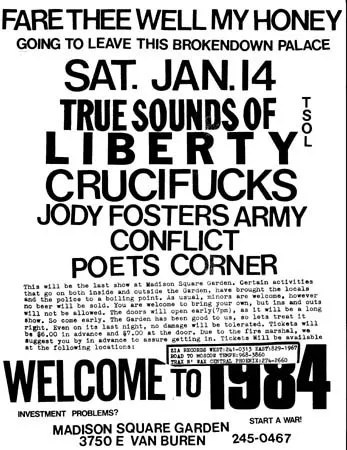
A MSG show flyer from January 1984.
Courtesy of Hardcore Show Flyers
Young and Dumb: “This is the show [January 14, 1984] that stands out most for me, and one of the last at Madison Square. It featured T.S.O.L., JFA, Conflict, Crucifucks, and Poets Corner. I was maybe 15 at the time, and it was maybe my fourth or fifth concert. And we’d ridden with some older guys, and this was [their] home base for shows at the time. It totally blew my mind.”
In the Thick of It: “I’d seen shows before, including a few at Mesa Amphitheater. But going from there to Mad Gardens, where it’s all right in your face and you have access to talk to people. I watched Mighty Sphincter with Jello Biafra. I talked to D. Boon at another show right before he passed.”
A Physical Attack: “There used to be this chain-link fence there, and I remember people climbing up and just dropping backwards. It was the first time I ever slam-danced. I also remember I wore a leather jacket, and we’d take turns wearing it because we thought it’d protect us, but it didn’t help at all.”
Rise and Fall: “I tried to go to every show after this one. There were maybe 300 to 400 regulars at the time. There’d been other places, like the Temple on Central, which ran for maybe six to eight shows before a gun got pulled and it was shut down.”
Rep Your Pals: “They had bands like Social Distortion and Black Flag play, but also local slots, and the local bands were just as good as those other bands. They always got a lot of support. They tried to do something different, and it was cooler to mix it up and not have four bands that sound the same.”
See Ya, Alligator: “I think a lot of bands thought by ’83/’84 the scene was dying, especially as the hardcore thing was happening … Victory Acres moved to Canterbury [Suites]. Don Bolles [of the Germs] migrated from Phoenix to L.A.”
The Bond Remains: “All my friends were in ninth grade, and we all lived in Chandler and we just had no idea how we felt. But that’s when everything changed, and most of us that went started up bands after that. I’m still friends with a lot of those people, and now there’s this huge community on Facebook.”
Michael Cornelius (JFA, Jr. CHemists) and Brendan deVallance (Jr. CHemists, Advo-Cats)
Hate House
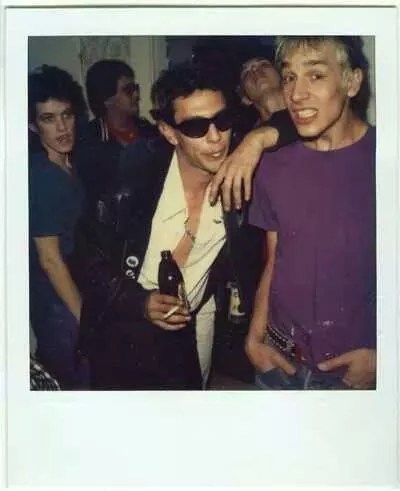
Charlie Monoxide and Rick Bertoni hang at the Hate House circa 1980.
Courtesy of Robin Grotjan
So Many Starts: “Hate House was where people who were making stuff happened to congregate [near Third Street and Palm Lane]. Prefix from Tucson played there, and so did The Deez and Meat Puppets. It’s where I asked Brian Bannon to be in JFA. He came rolling in there at 2 or 3 in the morning, and I was like, ‘How do you know where this is, kid?'” And I asked him if he can scream and he screamed real loud in my ear.” MC
Summer Child: “To my total naiveté, I didn’t know at the time everyone was a junkie. I didn’t hang out in that scene, but I hung out there. The Deez [“co-owner” Rick Bertoni’s band] were clearly named after drugs.” BD
Crime of the Century: “There was some shady stuff going on there, especially in the basement, the Detox Lounge. They were clearly burglarizing houses to to be able to support [their drug habits]. Tom [Small, another resident] gave me a violin once, probably ’cause he couldn’t hawk it. But they were very talented people; Rick was a really great artist.” BD
For the Record: “If you listen to that Jr. CHemists show, that’s where you can hear the raw punk and the chaos of it. There are people fighting, and the power was unplugged three times ’cause people were being assholes. Playing the Hate House, there was just too much punk-rock behavior. But it’s the only place where we could play, so you didn’t have much choices. There was never a shitload of people there, maybe 20 to 30.” MC
A Time and Place: “My question is, in that 18 months or so [approximately] it was around [circa 1980], there were only so many things going on before they had to lay low. So there were only a few key things. But there were places, like [Fireman’s Lodge] in Tempe, that if you weren’t there, then you weren’t in the punk scene. It was kind of like that at Hate House. It was not a great venue. People plugged their mics into the amps. It was a place we could play and knew we wouldn’t get kicked out.” MC
Misfits Assemble: “There were only so many people in the scene in ’78/’79. It was an infinity smaller town, this scruffy desert town and not that major metropolitan it is now. And so that’s how you get away with a rundown, dumpy house as a venue. No one cared about Palm Lane at that time. But there was a camaraderie of misfits. If you were a little straight jock, you’d get kicked out.” MC
A Scene Remains: “Stuff was always going to happen regardless, and there were other places. It was useful, a kind of focus. It’s not that the scene wouldn’t have happened; I already knew Don [Pendleton, of JFA] and the Meat Puppets were doing [their] thing. It was a place when something wasn’t happening elsewhere. I call it more of a crossroads than a nexus. When Hate House died, the punk scene didn’t. It grew.” MC
Friends Forever: “People like [house regular] Charlie Monoxide were always big supporters, right up there advocating for his friend’s bands. One time, Agent Orange were in town and they wanted to play Hate House. I was playing with Advo-Cats, and they wanted to play right that moment. Charlie wouldn’t have it and stopped them from making us move.” BD
Big Deal: “We didn’t care if it was there. We could even tell it probably wasn’t going to be there for long. All it was was a living room with no PA, and we didn’t put much thought.” MC